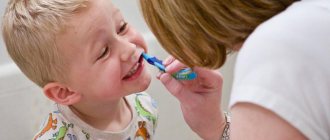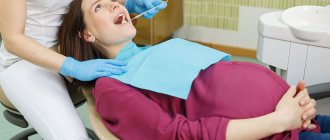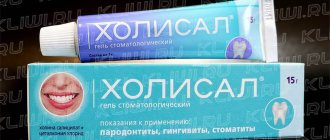Harm of X-rays for pregnant women
Sometimes, while expecting a child, women need to sanitize their oral cavity. And in order to properly plan therapy, an orthopantomogram is often required. “Is it possible to take dental x-rays during pregnancy? What are the consequences? - expectant mothers often worry.Indeed, irradiation is undesirable during this crucial period. But in reality, not everything is as scary as you might think at first glance.
How dangerous is x-ray?
In many cases, dental treatment is simply unthinkable without X-ray examination. When you can't do without it:
- when filling thin and curved tooth canals;
- to detect hidden carious cavities, caries under fillings;
- when the question arises whether wisdom teeth need to be removed (for example, if they are incorrectly positioned);
- to diagnose a tooth root fracture, cyst, determine the degree of inflammation of the tissues around the diseased tooth;
- when the issue of removing or restoring a tooth is being decided.
In the first three months, it is not advisable to take dental x-rays for pregnant women, since the fetus has not yet formed. Radiation can have an adverse effect on dividing cells, cause chromosome abnormalities and provoke intrauterine developmental defects. By the second trimester, at 16–20 weeks, the fetus is already fully formed - a tiny dose of radiation will not harm the baby in any way, so pictures can be taken without fear.
Dental X-rays during pregnancy are much safer than examinations of the pelvis or chest, because the mother’s belly is reliably protected by a lead apron, and dental examinations are always carried out using special devices with reduced radiation exposure. This applies to both old models and modern visiographs.
When you can't do without dental x-rays
Blind dental treatment is not recommended for anyone, especially expectant mothers. Thanks to an x-ray, the doctor sees the cause of toothache, the location and form of the inflammatory process, and other important nuances.
Diagnostics is prescribed for:
- filling root canals for pulpitis - it is necessary to determine the shape and length of the canal;
- problematic growth of eights;
- formation of cysts, granulomas and other neoplasms;
- suspected periodontitis (inflammation of the periodontal tissues);
- fracture or tooth root injury.
Visiograph - an alternative to x-ray
A visiograph is a modern analogue of an x-ray machine. Its advantages:
- Allows you to take an image instantly, high-quality data is immediately displayed on your computer monitor.
- A narrow beam of rays is directed exclusively at the diseased tooth, does not affect adjacent tissues, and certainly cannot “touch” the abdomen.
- The duration of exposure (irradiation) is 10 times lower than when using old-style X-ray machines and is only 0.05–0.3 seconds. Radiation exposure is only 2 microsieverts (when using old devices - from 7 to 80 microsieverts).
For comparison, just sitting in front of the TV for three hours and enjoying your favorite series, a mother receives a radiation dose of 5 microsieverts. The safe radiation dose per year is 1,000 microsieverts (that’s 500 shots). Of course, you shouldn’t take the procedure lightly, but you shouldn’t panic and overestimate the danger to the baby either.
Radiation doses and safety –
A patient's radiation exposure is measured in either microsieverts (µSv) or millisieverts (mSv). The recommended radiation dose for the population received as a result of X-ray studies (according to the recommendations of SanPiN 2.6.1.1192-03) should not be more than 1000 μSv per year (= 1 mSv per year).
Below we will give examples of different types of images in dentistry and the corresponding radiation exposure to the patient (data from the Ministry of Health of Russia dated July 22, 2011 and December 21, 2012)…
- Targeted images on a digital radiovisiograph – → lower jaw in adults – 2 μSv, → lower jaw in children under 15 years old – 1 μSv, → upper jaw in adults – 5 μSv, → upper jaw in children under 15 years old – 3 μSv.
- Sight shots using film – 10-15 µSv.
- Digital panoramic image – 55 µSv, but if the patient is less than 15 years old – 24 µSv.
- Digital teleroentgenogram – 7 µSv.
Conclusions: thus, targeted images using a radiovisiograph provide the lowest radiation dose compared to other types of x-ray examination in dentistry. During one visit to the dentist, you can take 5-6 pictures on a digital radiovisiograph without risk to health, but no more than 100 such pictures during the year. A digital orthopantomogram (panoramic x-ray of the jaw) can be done 1-2 times a month, but no more than 10 times during the year. Panoramic films on film provide a greater radiation dose to the patient, and they can be taken less frequently than digital ones.
How to minimize risks
What should an expectant mother do so as not to worry about the baby’s health?
- Not all clinics, especially municipal ones, have visiographs. It is better to inquire about this in advance.
- Be sure to use a protective apron and collar.
- You need to inform your doctor about the exact timing of your pregnancy. In case of a delay, even if the test shows a negative result, you must inform the specialist. In unclear situations, diagnosis (and treatment) are carried out as if pregnancy was definitely established.
- Severe pain, swelling, inflammation are good reasons not to delay a visit to the dentist, even in the first trimester. Unless absolutely necessary, the doctor will never prescribe dental x-rays during pregnancy and will try to do everything to postpone treatment to the 2nd, safe trimester or to the postpartum period. However, some acute conditions may require emergency intervention, such as purulent pulpitis or acute periodontitis. In this case, the mother needs to remember that a rapidly developing infection in the oral cavity will cause much more serious damage to the baby than 1-2 pictures on a visiograph.
- If there are concerns that the X-ray has somehow damaged the baby, you should consult with a geneticist and do an ultrasound. This will reassure those mothers who may have taken the photo without knowing that they were expecting a baby.
Since dental treatment during pregnancy is still associated with certain difficulties, the best thing an expectant mother can do is to go to the dentist and have all her teeth treated at least a month before the date of planned conception. And already in pregnancy, mommy should brush her teeth thoroughly and eat foods high in calcium.
Is it possible to use a visiograph during pregnancy?
During pregnancy, a woman has to go to a dental clinic for help. Sometimes, to correctly diagnose pain symptoms, it is necessary to take an accurate picture. You can’t do this without the help of a modern visiograph!
But what effect does it have on pregnancy?
In order to prevent any unpleasant consequences for the fetus, it is not recommended to use even state-of-the-art low-dose devices to obtain images in the first half of pregnancy. For medical reasons, if there is an urgent need for an effective examination, pregnant women can be prescribed an examination using a visiograph, but not more often than the norms specified in SanPIN and only in the second half of pregnancy, that is, at 4.5 - 5 months.
A one-time exposure to a visiograph does not pose a serious danger, and it is no more than what a person sometimes receives while walking through a city park. But, nevertheless, risks to the health of the woman and her unborn child should be minimized.
In conclusion, we can say that modern science has not fully explored the effects of minimal doses of X-ray radiation on the human body. In modern technology, there are dose limitations when performing medical x-ray procedures. For each patient it should not exceed 0.001 sievert per year.
CT scan during pregnancy - Rules
Let’s make a reservation right away: pregnant women do not require any special preparation for CT scanning. The only thing: their tummies are covered with a special lead blanket that reflects X-rays. And also: the radiologist provides the woman with the minimum dose of radiation, which is not an obstacle to a detailed examination of the desired part of the patient’s body.
Doctors do not advise pregnant women to be diagnosed using computed tomography using contrast agents. These medications may have a negative effect on the fetus.
Let's talk about the safety of CT diagnostics for the pregnant woman and the fetus
The computed tomograph uses well-known x-rays, which have a negative effect on the fetus. That is why CT examination is, in principle, contraindicated for pregnant women, which is quite understandable. But, as mentioned above, in urgent cases this examination may be prescribed.
Possible abnormalities in fetal development during a CT examination of a pregnant woman depend on the stage of pregnancy. The use of multislice CT in diagnostics in the early stages of pregnancy is strictly prohibited, since this can be fatal to the embryo by changing the structure of molecules and atoms.
There is a list of parts and areas of the body permitted for examination with a CT scanner.
CT examination in pregnant women is allowed for:
- brain;
- chest;
- heads.
A CT examination of the abdominal organs is allowed only if it is impossible to identify the pathology in any other way. But then the woman faces termination of pregnancy.
Dental treatment in the third trimester
The third trimester lasts from 27 to 40 weeks. At this stage, all the baby’s organs are already formed, dental treatment and many other dental procedures are allowed. Usually during this period a woman experiences bleeding gums, which indicates a calcium deficiency in the body. Also, one of the common problems in the third trimester is tooth decay. Fortunately, it is successfully treated without causing complications in the mother and fetus. The most serious diseases that pregnant women may encounter include gingivitis and periodontitis. In the early stages, they can be dealt with.
Modern dentistry has come a long way in recent years, so there is no need to be afraid of the treatment methods and anesthetics offered by dentists. High-tech equipment allows you to get rid of any problem associated with teeth without experiencing any discomfort. There will be no harm from the painkiller injection; treatment in the third trimester is always successful. The same can be said about tooth extraction, if the need arises for this operation.
What you should wait on in the third trimester until the end of pregnancy:
- Removal of wisdom teeth;
- Implantation.
At the very latest stages, the uterus is especially sensitive to outside interference. There are often cases when a pregnant woman is taken from the dentist's chair to the hospital for premature birth. Therefore, in the period from 30 to 40 weeks, you need to resort to the services of dentists only in an emergency.
What does it show
CT scans provide more detailed images compared to traditional x-rays. This is due to the fact that photographs are taken from different angles and in different sections.
The method allows you to assess the condition of the following structures:
- teeth;
- soft tissues of the face;
- bone structures;
- temporomandibular joints.
Computed tomography helps identify abnormalities:
- inflammatory foci;
- presence of foreign bodies;
- uneven dentition;
- bone damage;
- neoplasms;
- dental damage.
Carrying out procedures
All dental procedures are carried out after a preliminary consultation with a gynecologist and a general assessment of the need for dental intervention. A thorough examination and high-quality anesthesia are the key to effective treatment of diseases of the hard and soft tissues of the oral cavity.
Regular examination by a dentist and timely prevention of oral diseases are integral components of the health of the mother and fetus. You should not put off visiting a specialist and hope that the problem will solve itself. Modern dentistry has made a big leap in treatment, pain relief and treatment procedures for pregnant women, so if you doubt whether it is worth treating your teeth during pregnancy, then yes, it is definitely worth it.









